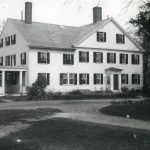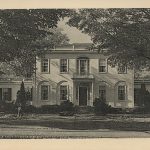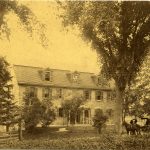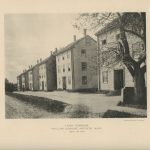Resources:
Campus History Walking Tour (under construction):
Campus maps and plans are online HERE
Domingue, Robert A. Phillips Academy: An Illustrated History of the Property (including Abbot Academy). Wilmington, Mass: The Hampshire Press, 1990.
Academy Hill: The Andover Campus 1778 to the Present. Phillips Academy/Addison Gallery of American Art. 2000.
Andover Preservation Commission: site includes information about buildings listed on the National Register of Historic Places within the town of Andover
Timeline created by Gail Ralston, 2019.
1765 Blunt Tavern established on north side of Salem Street just east of the present Commons location. From 1923 called Berry House when used as boys boarding house. Torn down in 1930 to make way for Commons construction.(Fuess mentioned it had at one time been called Johnson House.)
1777 Site in North Andover near Lake Cochichawick, where Samuel Phillips, Jr. grew up, was looked at for first school. When Phillips realized it was not possible to purchase enough land for potential future expansion, he looked to the south parish where his grandfather had lived. On January 24, 1777, Solomon Wardwell deeded to Esquire Phillips 17 acres on which stood “an old house and a joiner’s shop.” The Carpenter Shop was later used as a “singing house” and then used to store rags. Sold in 1803; torn down in 1845.
1777 Old (George) Abbot House; located on north side of Phillips Street west of the site where the Latin Commons were eventually located. This property was deeded to Esquire Phillips on March 1, 1777. Here is where the constitution of Phillips Academy was signed and the early meetings of the trustees were held. First Andover home of Esquire Phillips; then home of Eliphalet Pearson and other principals. Last used as boarding house and eating club for Academy boys; torn down in 1889.
1778 Academy established by Samuel Phillips, Jr. in a renovated carpenter shop on the corner of Main Street and Phillips Street, site of the present-day archeology museum. First Academy building was used for “recitation.” Founded and endowed on April 21, 1778, by Samuel Phillips, Sr. and brother John Phillips. First opened on April 30, 1778, with 13 pupils under the tutelage of Eliphalet Pearson. Incorporated on October 4, 1780.
1787 Mansion House built (stood where open lawn now is across from Bell Tower), for Samuel Phillips and Phoebe Foxcroft Phillips. At time, “largest and most impressive dwelling on Academy Hill. Stood as a landmark of both the school and the town.”
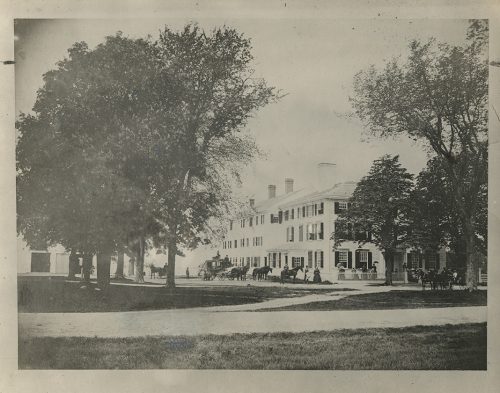
When Phillips family was no longer there, the Mansion House was run by the Academy as a boarding house, then as a tavern and inn. In 1887 it burned to the ground.
1785 to 1786. “Wood Academy” – known as the “Second Academy” – was built across the street, near the present-day Armillary Sphere.
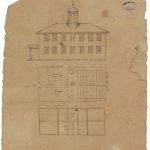 The Academy was a two-story structure, with recitation and study on the first floor and exhibition space on the second; burned in 1818.
The Academy was a two-story structure, with recitation and study on the first floor and exhibition space on the second; burned in 1818.
pre 1787 Blanchard House, built for John Blanchard, was originally located on Salem Street across from Hardy House west of Blunt Tavern. Oldest surviving dorm building. When John’s nephew Amos Blanchard inherited the home, he boarded boys there as early as 1802. (Amos himself had boarded there while attending PA from 1787-1788.) In 1880s home to “eccentric” Clough family. Building first moved in 1858 about 100 yards east on Salem St, closer to Blunt Tavern; then moved to Hidden Field Road in 1928 to accommodate construction of Commons. Deemed unsafe and razed March 13, 2017.
1796 Before Tucker House was built at the southwest corner of Main and Phillips Street, Samuel Phillips, Jr. built a house and barn as an investment (he never lived there). Known as “the Old Farmhouse,” many out buildings extended west down Phillips Street. Various tenants operated it as a country store and dairy farm, supplying milk to the Academy. In 1818 after the Second
Academy burned, classes were held there for several months. In 1830s, it was used as one of the central dining houses for the Academy. In 1880 the main house was moved (54 Morton Street, north side) to make way for Tucker House.
1800 pre- (no exact date available) Comstock House. Located originally on the Highland Road extension (originally “Bank Street”) that used to exist between Salem Street and Main Street. It was a Seminary faculty house by 1886 and was named for David Young Comstock. In 1908 it was listed as a bindery and may have been part of Mark Newman’s store ventures. When construction began on the Memorial Gym, it was moved to its present location on Hidden Field Road.
1800 (early, no exact date) Clement House built west side of School Street; deeded to trustees in 1829 by John Clement, teacher.
Clement House was used as a “dining” boarding house; converted to girls’ dormitory in 1973 following Phillips Academy’s merger with Abbot Academy.
1800 (early, no exact date) Carter House; originally known as Mary Griffin House and then the “Tract House.” Named for Emily Carter who spearheaded the drive for building the Andover Cottage in 1891. Renovated in 1952 as faculty housing. (153 Main Street)
1801 Hardy House (at one time called Adams House) was purchased by the Academy from Captain Asa Towne. Second oldest surviving structure on campus, and at one time said to be the oldest home on Andover Hill. Purchased as first Academy-owned dorm on campus, though never used as dorm. Renovated as residence of Eliphalet Pearson and family when Pearson returned in 1806 to establish Theological Seminary. Home to John Adams and family, 1810-1833. William Graves, who structured the Academy’s science program, later lived there for more than 40 years. In 1912 officially named for Alpheus Hardy, an alumnus, trustee, and state senator. Became the admission office in the 1970s; renovated as the Shuman Admission Office in 2000.
1803 to 1840. Treasurer Samuel Farrar supervised construction of Academy buildings.
1804 to 1806. Essex Turnpike (now Main Street) was constructed. Prior to that time, the only street that existed was School Street that led to the South Church meeting house. When Essex Turnpike was built, it merged with the “School Street” section that existed between Moses Stuart House and Double Brick, hence creating the wide section of Main Street in front of the Academy.
1805 Hayward House. Originally built in Boxford; moved to present location in 1805 by team of oxen. Served as home of paint shop until replaced by Smith Building. In early 1900s used as 2-family, then single-family. It was remodeled in the 1930s as retirement home for Thomas Cochran, who died before he could move in. Students were then housed here until 1959. Currently serves as faculty housing. (25 Phillips Street)
1809 Andover Theological Seminary established with 36 students to start. Seminary provided housing for boys; for first 50 years, Phillips Academy did not. For first 40 years, Academy also did not have a chapel on campus.Seminary plans included creation of the Elm Arch.

1808 to 1821 “Seminary Row” was built:
Phillips (Foxcroft) Hall (1808-1809), served as dorm, classrooms, chapel;
Bartlet (Pearson Hall) Chapel (1817-1818), became chapel/classrooms;
Bartlet Hall (1820-1821), built as dorm. Minor fire in 1912; major fire in 1914; rebuilt in 1915. As a result of these fires, Academy established a campus fire academy.
1808 to 1810. Wooden dining hall for Seminary built east of Seminary Row behind Phillips (Foxcroft) Hall. Called “The Refectory,” it was abolished in 1845 and moved in 1848 to its present site at southwest corner of Main and Morton Streets.
1809 to 1810. Phelps House built. Claimed to be “architecturally, the finest house in Andover (from Historic Houses in Andover, 1946); built for the holder of the Bartlet professorship.
Named for Austin Phelps, Professor of Sacred Rhetoric at the Seminary, who lived there with his family for 31 years. His daughter was novelist Elizabeth Stuart Phelps Ward. (Restored small building in rear was her writing study.) Fuess was the first headmaster to live here; Headmaster John Kemper continued the tradition.
1810 Cemetery constructed. Originally called Chapel Cemetery.
 Buried here are Professor Calvin and Harriet Beecher Stowe.
Buried here are Professor Calvin and Harriet Beecher Stowe.
1810 to 1812. Moses Stuart House built. First home to Moses Stuart, noted Hebrew scholar and prominent figure at the Seminary. “Old Hill Store” built for Mark Newman south of Newman House (see below) at corner of “South Main and Back Streets” as general store. (Back Street later became the Highland Road extension that was eventually closed off from Salem Street to Main Street.) In 1813 Eliphalet Pearson established here the Seminary Printing Press on the second floor. Flagg, Gould, &; Leavitt (binder) hired to run press. Moses Stuart published book on Hebrew Grammar (first in country) in 1813. Printing Press could print in 13 separate Asian languages (among others). When this space was outgrown, a separate Print Shop was built (see below, 1832). Old Hill Store was demolished in ? Homes for Flagg, Gould and Leavitt, were built at 234, 238, and 244 Main Street. This area known as “Book Row.”
1811 Newman House built as residence of Academy Principal Mark Newman. After Newman, home later became a famous stop on the Underground Railroad. Young Oliver Wendell Holmes boarded here in 1824.
1811 to 1812. Farrar House built; later moved down Phillips Street (in 1881) to present location (just west of original Abbot house site) to clear the way to add Churchill House to the Seminary Faculty Row.
1815 to 1816. Pease House First known as the Leonard Woods House, then Gulliver House.
1818 to 1819 After the Wood Academy burned,the Brick (Third) Academy (Bulfinch Hall) was built, used initially as classrooms. Subsequent uses included a gymnasium, dining hall, and home of the Phillips Academy English Department.
1824 Samaritan House (where present-day Chapel is located) was built as an infirmary for Academy and Seminary students. Became residence of the Academy principal in 1828. Moved to present site in 1929 (as part of Platt campus design). Ceased to be used as Headmaster’s home in 1933 (when Clause Fuess took over Phelps House as his home).
1825 Blunt House, more popularly known as America House, built. First used for Andover Theological students. Here Samuel Frances Smith wrote “America” in February, 1832. Building underwent at least two major remodelings; major fire occurred prior to 1850. Current style occurred right after Civil War. (147 Main Street)
1828 Abbot Academy established with Academy (Abbot) Hall as main building. No dorms yet.
1829 Stone building (“The Workshop”)/Stowe House built on Chapel Avenue as workshop for Seminary students; provided opportunity for carpentry work and exercise. A group called “the Mechanical Association” fashioned coffins, wheelbarrows and other useful articles. Later it became a gym for both Seminary and Academy students. Building was vacant when Harriet Beecher Stowe (and her husband, Calvin E. Stowe, professor at the Theological Seminary) came to campus in 1852 and had it converted to a residence. Until she left in 1864, Mrs. Stowe was well-known for her parties and holiday celebrations, even celebrating Christmas at a time when it was not yet condoned as a holiday.
After the Stowes left, the building was used as a dorm until 1887 when fire did extensive damage. It was then renovated as Phillips Inn, replacing the function of the former Mansion House on Main Street that had been destroyed by fire that same year. (Mr. Carter, former proprietor of the Mansion House, leased the building; it was remodeled as a hotel and also called the Mansion House for a while.) A large wooden addition was added to the Inn in 1893. Both the addition and porch (that the Stowes had built) were removed when the building was moved to Bartlet Street in 1929. The porch was relocated to behind the barn at 148 Main Street.
1829 to 1830 Teacher’s Seminary established by Board of Trustees in “Stone (Fourth) Academy” on northeast corner of Main Street and Chapel Avenue (west of current Cochran Chapel) to train boys as grammar school teachers, not to go on to college. Samuel Farrar, architect of the building, also intended the structure to house the “English Classical School.” Building outfitted for chemistry, physics and; geology, surveying instruments, and included a library.

1829 to 1830. Double Brick (Abbot House) built. Samuel Farrar financed its construction. Students who lived there paid rent; presumably ate meals at “Old Farmhouse” just up Main Street. Once home to Principal Samuel Taylor and Headmaster Cecil Bancroft. Currently faculty residence and dormitory. (169 Main Street)

1830 English (1834-35) and Latin (1830-32, 1835) Commons built for scholarship boys; English Commons as dorms for Seminary Students on Old Campus Road; Latin Commons as dorms for Academy students on Phillips Street.
In 1903, two Latin Commons buildings were moved to downtown Andover behind Punchard High School; razed soon thereafter. Other Latin Commons buildings were torn down. In 1906, one English Commons building was moved to Highland Avenue (razed in 1988); the remaining buildings were torn down.
1832 to 1833. Print House built south of Mansion House. Built by Flagg & Gould (with Mark Newman) for their printing office, having outgrown Newman’s store across the street south of the present Bell Tower. In 1854, a bookstore was added by Warren Draper. In the 1860s, Draper took the entire operation downtown. Building became a boarding house, then a dorm (1904) for scholarship boys, called Brick House, for the Academy. In 1870 became “famous” as the location where the first of the campus “secret societies”, the ODA, was spawned. In poor repair, the building was torn down in 1912. (Draper Cottage was later built from funds donated by Draper).
1833 to 1834. Park House Home for 64 years to Edwards Amasa Park, one of the most important religious thinkers in 19th century America; joined Seminary as Professor of Sacred Rhetoric. Daughter lived there until 1922, renting rooms to Academy students. Now residence and dorm.
1840 By now, the “Old Farmhouse” was used as a dining hall called Latin Commons Boarding House or “Chocolate Hall.” By 1852 was formally the first of the campus “eating clubs,” known as The Union Club. Other “eating clubs” that were well known were The Eureka Club (1857), the Mutual Club (1865), the Shawshine Club (held in the old Abbot House on Phillips Street, The Crescent Club, and “Major Marland’s,” located in the present Clement House on School Street.
1840 Cheever House built at intersection of Main and School Streets. Served as book store, residence and dorm. Razed in 1981.
1842 Teacher’s Seminary disbanded (after only 15 years). Its buildings merged with those of the Academy. “Used after 1842 as the Recitation Building (of the English Department) for Phillips Academy, it became the center of school life.” It was destroyed by fire in December of 1864.
1848 to 1917. PA boys boarded at Ellis House at southeast corner of Main and Morton Streets. Named after painter Nathan Ellis. Ellis daughters had a Dame School for Girls here as well. After 1917 reverted to private apartments and later converted to dormitory for ABC Organization.
1850 1924 House First existed as Phillips District School where Memorial Gym is today. Sold in 1890; moved to where Case Memorial Cage is, and renovated as home for Theological Seminary. The Academy purchased the dwelling in 1901 and moved it to Highland Road as faculty residence. Known as the Willis House in the 1950s. Class of 1924 paid for large meeting room addition at the back, and thus became known as 1924 House. Structure moved again in 2001 east down Highland Road (between Stuart and Fuess) to make room for new Gelb Science Center.
1854 Smith Hall built as Abbot Academy’s first dorm for Abbot girls. Furnished with funds raised by Mrs. Samuel C. Jackson and Mrs. Harriet Beecher Stowe. Expanded in 1866 when water and bathrooms were added. Moved west in 1887 to make room for construction of Draper Hall. Fire damaged building in 1894. Closed in 1897; razed in 1907.
1865 Two adjoining homes purchased for additional Abbot Housing; named Davis Hall to the north (also known as French Hall, 1869-1890, when it was razed to
make room for McKeen Hall) and South Hall to the south (built circa 1832, also known as German Hall from 1878-1892). South Hall eventually was moved to Abbot Street for Philena McKeen’s retirement and renamed Sunset Lodge.
1865 Brechin Hall built (on site of Wood Academy/Armillary Sphere). Built by the Andover Theological Seminary, it served as a library on second floor, and a museum honoring the seminary’s graduates at ground level. When the Andover Theological Seminary left campus, became Phillips Academy’s administration building in 1910.
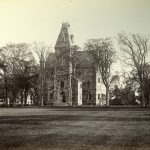
1865 to 1866 After fire destroyed the Stone Academy, the Academy built a Main Recitation (Fifth Academy) Building with classrooms, a chapel and a library, at the intersection of Main and School Streets, where Samaritan House is today. Original third floor removed in 1902; front portico removed in 1910. The Main Building was torn down in1927, after Samuel Phillips Hall had been completed, as it was deemed structurally unsound.
1865 After Main Academy building was completed, Bulfinch Hall abandoned as academic building of the Academy. Was now used as a gymnasium with boxing and bowling facilities.
1869 Draper Homestead built by publisher and Abbot Trustee Warren F. Draper. Served as small dorm in 1882; residence house in 1918. Private home in recent years.
1870 to 1950. Secret societies existed on campus. Separate “homes” built for each fraternity including:
Brick House (1870) – ODA – first of secret societies.
Graham House (1915) – AUV (previously at 123 Main Street)
Tilton House (1930) – PLS; fifth location; 1940 named Tilton House.
Alumni House (1901) – KOA (originally in a home at 10 Locke Street)
Cooley House (1908) – PAE (previously 131 Main Street). Cooley House used as Athletic Association headquarters in 1950; in 1980 converted to a student center; currently Summer Session Office.
Newton-Hinman House (1921) – PBX (originally at 63 Highland Road).
Benner House (1928-29) – AGC (third home; later used as snack grill for students)
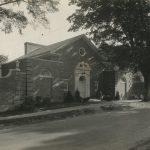
Davison House (1928) – FLD (originally at former KOA House).
63 Highland Road – EDP (1890s) (formerly PBX).
5 Locke Street (1897) – Sphinx
McCurdy House (~1902) – SPA. (49 Highland Road)
1875 Clock tower added to Pearson Hall.
1875 to 1876 Stone Chapel built in the area north of the present-day Addison Gallery. Initially accommodated about 500 people. Stained glass was used extensively. Bell in the tower was designed after the Independence Bell in Philadelphia in memory of Josiah Bartlett, the first signer of the Declaration of Independence. New organ was installed in 1887.

The Stone Chapel became property of the Academy in 1908, the same year a new organ was installed in memory of William Egleston, class of 1856. Chapel enlarged extensively in 1919 (with interior redecorated), seating 240 more. Chapel’s organ moved to South Church before building was torn down in 1931.
1880 Chandler Farm existed at the end of today’s Chapel Avenue (where “turn-around” is) behind the Stone Chapel. Produce provided some of the needs of the schools. Academy and Seminary students worked on farm to help defray some of their expenses. Served as home for several Academy administrators, including Virgil Harrington, after whom it later took its name. Main house was moved in 1925 to Bartlet Street (current site of Stowe House) to make room for GW parking lot; razed in 1928 to make room for Stowe House.
1880 Jewett-Tucker House built; named for Reverend William R. Jewett who gave construction funds as incentive to bring adopted son William Jewett Tucker to Andover as Bartlet Professor of Sacred Rhetoric. Moved from Main Street in 1928 to Hidden Field Road (to make way for Vista).
1881 Sanhedrin built as small brick laundry and bathhouse for Seminary students. Located behind Seminary Row’s Pearson Hall. Moved in 1922 to West Quad and used there also as music hall.
1881 to 1883/1891. Graves Hall, named for William B. Graves, head of the Science Department, 1866-1899, built as science building for the Academy. Used for science until Morse Hall construction in 1928. Later headquarters for the Music Department. Renovated in 1983.
1883 Churchill House built on northwest corner of Phillips and Main Street
(former site of Farrar House). Moved south on Main Street in 1901 to make way for Peabody Museum.
1884 to 1885. Phillips Hall built as Academy’s administration building for principal, trustees and treasurer’s office (with walk-in vault). After administration moved to Brechin Hall in 1910, it became the Phillips Club, used by faculty as a retreat and the only place on campus where faculty could smoke. It later served as the CAMD, Summer Session and Work Duty offices and, currently, houses Public Safety.
1887 to 1889 To accommodate Draper Hall on the Abbot campus, Smith Hall moved west toward the Abbot Grove (Smith Hall renovated in 1890s; experienced fire in 1894; repaired; then closed in 1897 and razed in 1907); South Hall (also known as Sunset Lodge and German Hall) moved to Abbot Street; Academy (Abbot) Hall in 1888 was turned 90 degrees and moved south.
1889 Draper Hall built on Abbot campus; badly damaged by fire in 1896; renovations occurred over the years. After the Abbot Academy merger with Phillips Academy (1973) Draper was closed after the 1976-77 academic year. Extensive restoration occurred in 1994 to save the structure; converting the building to faculty apartments and administrative offices.
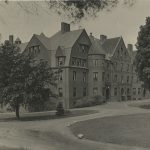
1890 Amos Blanchard (grand-relative of Squire Amos Blanchard of the early 1800s) built a new residence in Andover, seen as the center section of “Will Hall” after its full construction. Edward H. Williams, Jr. purchased the home in 1901 and substantially enlarged the structure into a gentleman’s farm estate. In 1910, Williams sold the house to the Academy well below market value. Williams Hall, as it was now known, was immediately converted into a dorm for Junior boys, who needed greater supervision than some of the other boarding houses provided. Carriage house became Junior House; out building became Stott Cottage. Unlike other homes, Will Hall had its own dining room where the boys ate, and those who lived there had to conform to special rules. By 1999 the Academy no longer needed the dorm, and explored alternative usages to avoid demolition. The Academy lent the dorm to the Town of Andover as a potential Senior Center. When needed Town funding was not supported by Town Meeting, the Academy felt it had no choice but to tear it down, which it did in 2002.
1891 In May of 1891 over six hundred Andover citizens gathered in the Town Hall to prove their strong support for Phillips Academy and Dr. Cecil Bancroft’s desire to have all boys housed in Academy-owned buildings. Pledging funds that day were a ladies committee of the Town’s women, Academy faculty, Seminary faculty, Thomas Holt offering a matching pledge, and Rebecca Mills who met that match. The subsequent student housing began first on a small scale, with four “cottages”: Pemberton (formerly Taylor) (1891), Andover (1892) named in honor of the town whose citizens enabled its construction, Draper (1893), and Eaton (originally called Bancroft) (1900). Draper Cottage had replaced one of the wooden English Common buildings, that had burned down and is still located near School Street on Old Campus Road; other cottages located on Old Campus Road near Isham.
1892 Eastman House on Highland Road Originally run as boarding house. Taken over by trustees in 1906 and used as dorm. Now serves as faculty residence.
1896 Brick Academy (Bulfinch Hall) burned; stayed empty for six years.
1899 Bancroft Hall built on Phillips Street.
1900 Morton House on School Street purchased by Mrs. Draper for Abbot Academy in honor of Marcus Morton, Trustee. Not used by school until 1950; served then as faculty apartments, then business office until 1973. Currently back to apartments.
1901 Andover Country Club erected club house and wind mill overlooking Rabbit Pond and near the campus “golf links.” The building was later moved to the Shawsheen area golf course. Rabbit pond had originally been the watering hole for ATS Chandler Farm.
1901 Borden Gym built with major funds from Matthew Borden, class of 1860, following fire in Bulfinch that destroyed the gymnasium there.

1901 to 1903. Peabody Archeology Museum Previously site of carpenter shop of original Academy; later site for Farrar House (moved west on Phillips Street in 1881) and Churchill House (moved south on Main Street in 1901). The original museum included a library, dark room and snack bar – The Grill – in the basement. The Grill closed in 1912 to open space for the museum.
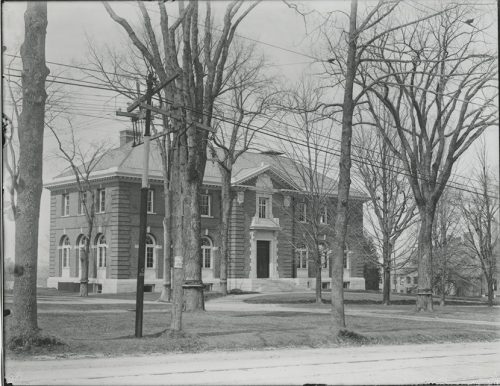
1902 After Bulfinch was gutted by fire in 1896, it was re-built as the Academy’s first “common” dining hall (1902-1936), fondly known as “The Beanery.”
1902 Before Andover Theological Seminary left campus, Academy rented Bartlet Hall.
1903 McKeen Hall built on Abbot campus where Davis Hall had been (in honor of Philena and Phebe McKeen). Included Davis Assembly Hall and Gymnasium organ loft and organ. Also several classrooms and a study hall for day students. After school merger, building used for storage. In the early 1990s was remodeled for administrative offices and community day care center.
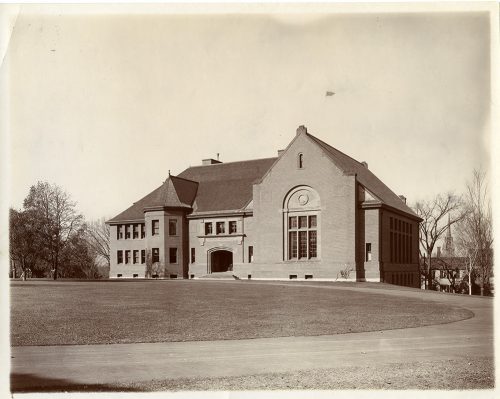
1902 to 1950. Home of Alice T. Whitney, long-time PA Recorder. PA Professor George Eaton had originally built house as part of family plot.
1903 Moorhead House First single-family residence built on Hidden Field.
1904 Anderson House (63 Highland Road). Built by Reverend George B. Frost as part of Highland Wayside development. Home first occupied by PBX fraternity. PA purchased entire group of homes in 1928.
1906 to 1907 John Esther Art Gallery added to Abbot Campus.
1907 Williston House purchased (32 Phillips Street).
1908 Theological Seminary left campus for good. Foxcroft now used as dorm.
1909 to 1922. Dorms continued to be added: Day Hall (1910), Bishop Hall (1911), Adams Hall (1912), Taylor Hall (1913), and Johnson Hall (1922).
1911 York Pool added to the Borden Gym.
1912 Abbot laundry built; still standing.
1913 Isham Infirmary built with funds from Miss Flora Isham in honor of her
three nephews who were alumni of the Academy. New wing added in 1934. In 1978 the north wing was renovated as a student dormitory.In 2017 it was converted to a student dorm and renamed Chase House in honor of former Head of School Barbara Landis Chase.
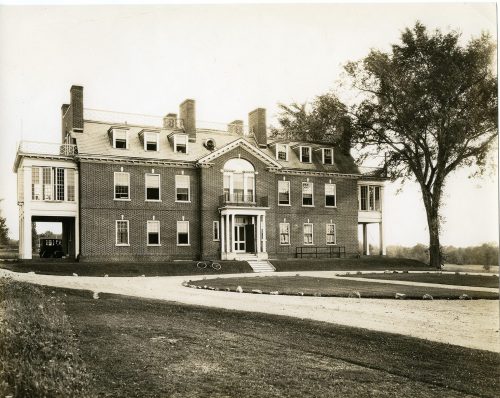
1913 Flagg House purchased by PA (orig. owner John Phelps Taylor) from Abbot Academy. Reverted to Abbot in 1923 and became home of Abbot Academy Treasurer Burton S. Flagg in 1926. In 1933 the lounge and kitchen areas above the garage were turned over to Abbot for use as teachers lounge. Was the only place Miss Bailey allowed her staff to smoke.
1913 to 1914. Abbot Academy builds Taylor Infirmary behind Draper Hall.
1913 to 1916. 74 Bartlet Street. Built by prominent local resident John V. Holt as private home. Acquired by Academy as faculty residence.
1914 Sherman Cottage on Abbot Street adjacent to Sunset Cottage – purchase from the Shearer family as residence house. Became locale for student escapades such as “coed roof parties.” Closed after 76-77 school year; restored as faculty house in 1979.
1914 Phillips Memorial Gateway constructed on east side of Main Street at the end of the Elm Walk, now the Vista. Moved to west side of Main Street near site of old Brick House and Mansion House.
1915 Peabody House was built behind the archeology building facing Phillips Street. Served as the Student Union building. Burned in 1981; demolished.
1915 Graham House (AUV House) built. Following disbanding of the secret societies in 1950 became center for Religion Department; named in honor of James Graham, instructor in natural sciences. Remodeled in 1967 as home office for Outward Bound; later became campus counseling center after that office moved from Isham.
1918 Fay House purchased (Main Street).
1919 Thompson House built for private family with no connection to the Academy.
NOTE: Going into the 1920s, Academy Trustees engaged in a debate on whether to develop a campus “West” of Main Street or “East” of Main Street. Architect Charles Platt submitted three scenarios and eventually the East Side of Main Street – behind Seminary Row – Plan was chosen. Worked extensively with Thomas Cochran who was an alumnus (class of 1890) and trustee. To create a great “Vista,” many buildings were moved or torn down in the 1922-1929 period.
1920 to 1925. Higgins House (3 Stonehedge Road) built. One of six houses built by Emery Trutt for Stonehedge Road development by employees of his box factory to provide work during economic lulls. Other homes include Forbes House (8R), Hay House (2), #6, #8 and #10. Acquired by the Academy in the 1968 period.
1921 Pearson Farm, on south Main Street, purchased.
1922 Pearson Hall was moved to its present location; restored to original appearance.
1922 Playing fields were laid out.
1923 Fuller Tower (now Memorial Bell Tower) was built on the east side of Main Street, different from the original plans to build it on the west side. The Bell Tower sits on the site of the old training field where young men of Andover prepared for some of the nation’s early battles; honors students who lost their lives in World War I. Site of many of the Academy’s celebrations with such presidents as Washington, Jackson, and Coolidge as well as the Marquis de Lafayette.
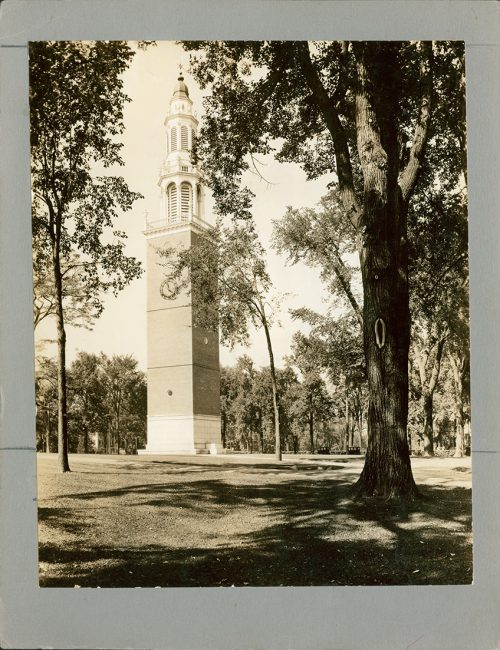
1924 Samuel Phillips Hall built as Academy’s main recitation bldg (Sixth Academy). Known as the “New Main Building” until the Trustees meeting of 1926 at which time it was named for the founder of the Academy. Funding came from over 2500 alumni and friends. Fifteen of the recitation rooms are named for key donors. Each instructor had his own classroom for the first time in the school’s history. Currently houses the World Language and History Departments.
1926 to 1926 George Washington Hall built as Academy administration building for offices of Headmaster, Registrar, Deans and Trustees. Included auditorium seating 1200. Martha Cochran Memorial Organ was installed. Major renovation in 1990, adding smaller but flexible theatre spaces (major donor trustee Oscar Tang in honor of wife Frances Young Tang, AA57) and enlarged student lounge.
1925 Harrington House existed on the corner of Wheeler and Bartlet (where Stowe House is today). After its move in 1925 from the end of Chapel Avenue, getting ready for other changes in that area and the relocation of Stowe House, it was ultimately decided to demolish the structure (1928)
1926 to 1928. Samuel F.B. Morse Hall built with bricks from the Old Academy Building as an economic measure, initially as the building housing the science department. Named for the inventor of the telegraph and Morse Code, who was an 1806 graduate of the school.
1926 French House purchased (89 Bartlet Street).
1926 Kellogg House. Abbot Academy listed as owner. Built as rental property by Ruby Carter; may have rented to students. Currently faculty residence.
1927 Wendell House purchased (23 Salem Street).
1928 Tucker House moved to Hidden Field Road from southwest corner of Main and Phillips Street to open up Vista. (Principal Stearns called the area of the relocation of Tucke House and Blanchard House “Rotten Row” in a play on words of the name “Faculty Row” Bancroft Hall also moved from Phillips Street to the West Quad and Pemberton Cottage moved from Phillips Street south to the other side of the cottages – all to accommodate the Vista!
1928 Woods House moved from Wheeler Avenue to Judson Road to make way for the Chapel. Harrington House (on Stowe site) razed in 1929 to open site for Stowe House.
1928 Armillary Sphere Designed by Paul Manship as “symbol of the world.” Axis of the sphere fixed at the angle of the earth at Andover.
1928 to 1929. Paul Revere Hall
1928 to 1929. Oliver Wendell Holmes (class of 1825) Library built, with major additions in 1959 and 1989. Largest secondary school library in country. Renovated 2018-2019.

1928 to 1930 Commons Dining Hall Blanchard House moved to Hidden Field Road to make way.
1928 to 1930 Moncrieff Cochran (Bird) Sanctuary built as bird refuge and nature preserve. Gift of Thomas Cochran in honor of his brother Moncrieff, class of 1900. Natural topography of 150 acres was reworked, damming streams for two new ponds, laying out gravel roads and building bridges.
1928 Smith House (57 Highland Rd) and Merrill House (17 Salem St) acquired.
1929 Brechin Hall and Stone Chapel from the Theological Seminary torn down to make way for a broad sweep of lawn. Sanhedrin torn down after having initially been moved by Platt (it was blocking the “Vista”) to the area in the center of the present Flagstaff Quad. The top floors of Foxcroft and Bartlet were removed to “fit in” with the surrounding buildings. Samaritan House was moved to its current location for Cochran Chapel construction.
1929 Log Cabin built.
1929 Power Plant built.
1929 to 1931. Addison Gallery built, funded by Cochran to expose Phillips boys to fine art and culture. Originally planned for space on the second floor of the Oliver Wendell Holmes Library. Named after a family friend, Keturah Addison Cobb.
1929 to 1930. Phillips Inn renovated. Became known as “Andover Inn” in 1940.
1930 Armillary Sphere, originally located in front of SamPhil, was moved to its present location at the southern end of the Elm Walk to keep the Vista open.
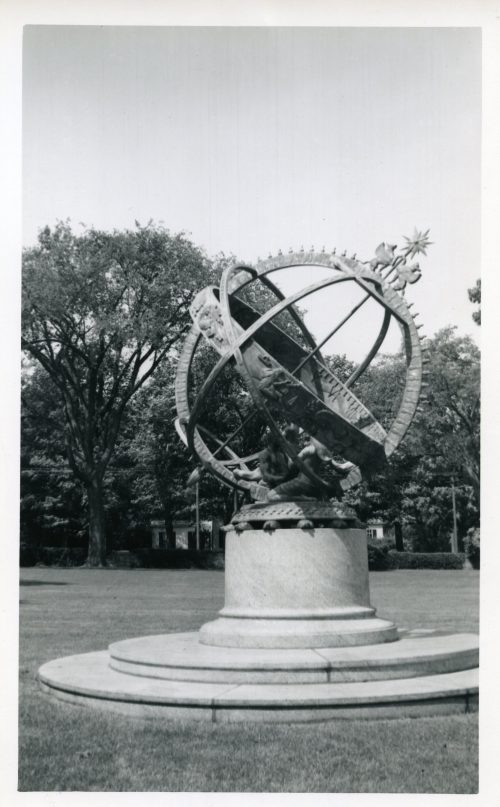
1930 to 1932 Cochran Chapel built, named for Thomas Cochran’s parents. Cochran paid for the entire cost of the Chapel as well as the cost and fees associated with the closing of Bartlet Street. (Note: Cochran had initially wanted to name it “America Chapel” in honor of Stephen Smith who wrote the song “America” while a seminary student; trustees overruled him.) Originally planned for the area where the Addison Gallery now is, it was later aligned with the Bell Tower; a section of the stone wall was also removed to create an open view. Not liking stained glass, Charles Platt insisted that all windows were to be clear glass. Original organ came from GW auditorium; a new organ was dedicated in 1981. Kemper Chapel in lower level was named for the first wife of Headmaster John Kemper. Baldwin Cloister was named for Rev. A. Graham Baldwin, school chaplain for many years. Dept. of Philosophy and Religious Studies also found a home there. In 1990, the stationary pulpit was removed, and in 1999 the “organ balcony” was enlarged (major donor Trustee and alumnus David Underwood ‘54 and Family), enabling the Academy to fully seat all faculty and students at one time.
1930 Abbot Academy builds Merrill Memorial Gateway, John P. Taylor Gate (near Esther Art Gallery), and George G. Davis Gate at corner of School and Abbot Streets. All three were locked during the evening and on Sundays a “physical and psychological barrier” between Abbot girls and PA boys.
1932 Coy House purchased (141-143 Main Street).
1933 Phelps House from this point becomes home to school’s Headmasters.
1934 to 1935 Rockwell House</strong
1935 to 1938 Hidden Field Road homes designed and built for faculty: Greenough House, Quincy House, Palmer House, Weld House, Lowell House. Originally known as “Little Siberia.”
1936 Allen House (1 Highland Road). Phil Allen, Phillips Academy trustee and Abbot Academy Board Chair, purchased home from Flora Temple who ran a vegetable farm.
to 1937. Bulfinch exterior restored, with Harkness money, as accurately as possible; interior spaces designed with an eye toward small, intimate classes. The hall becomes home to the English Department. The name “Bulfinch”nwas used for the first time. Small street leading to the back – Grub Street – was so named in 1983 for a street in London where writers lived.
1936 Chapin House (38 Phillips Street, 1840) altered. Originally home of Deacon
Fred Church, then G.C. Davis. Acquired by E.F. Chapin by 1906 who had the house extensively remodeled (after whom house was named).
1939 Abbot Academy builds Abbey House as dorm for 36 students, behind Draper Hall (between Infirmary and Laundry). Closed after 76-77 school year; restored as faculty housing in 1979.
1940 Cole House purchased (39 Salem Street).
1940 Erving House purchased (45 Salem Street).
1940 to 1969. Hayes House (28 Phillips Street) was home of Bartlett Hayes, longtime Director of the Addison Gallery.
1943 Burtt House purchased (26 Salem Street).
1946 Goodhue House purchased (15 School Street).
1946 Moody House purchased (34 Salem Street).
1950 Comstock House, built before 1800, moved from Highland Road extension to Hidden Field Road when work began on Memorial Gym.
1950 Sumner Smith Hockey Rink built (7 Highland Road).
1951 Memorial Gym added to Borden Gym in memory of alumni who had been killed in World War II.
1955 to 1956. Abbot builds Abbot Gym. Named for Trustee President George Ezra Abbot who died in 1953 during the fundraising campaign for the building. Abbot Gym converted to offices for Physical Plant at start of 1980.
1956 Jackson House purchased (11 School Street).
1957 to 1966 Next building frenzy. Dorms built included: Stearns (1957), Stevens (1958), Stimson (1960-1961), Fuess (1961-1962), and Nathan Hale (1966).
1960 Stirling House purchased (43 Salem Street).
1961 to 1963. Evans Hall built as Science Department exclusively. Torn down in 2003 to open space for a new Science Building, the Gelb Science Center.
1962 to 1963. Art and Communications Center built, housing classroom studios, an audio-visual center and an auditorium, connecting George Washington Hall with the Addison Gallery. Art classes previously held in basement of the Addison. Renovated in 1994 as the Elson Art Center.
1962 Wisconsin House (23 Woodland Road) and Wooley House (21 Woodland Road) built as “techbuilt design houses.” In 1963 open space between these homes and Highland Road became Kevin Rafferty Playing Fields in memory of Rafferty, class of 1934, who died in World War II.
1965 Salem House purchased (41 Salem Street, circa 1906).
1966 Brucato House acquired (75 Highland Road, circa 1889).
1967 Hearsey House acquired (42 Salem Street, north side). In late 1980s dedicated to Marguerite C. Hearsey, former principal of Abbot Academy, and converted to dorm.
1970 Elbridge Stuart House
1973 McDuffie House acquired (19 School Street). Former home of Alice Buck, prominent early environmentalist.
1977 Basford House acquired (31 Holt Road, possibly built pre-1830). Named for Emory Basford, head of the English Department during the Kemper years.
1979 Sides House acquired (21 Hiddenfield Road). Private home built by Robert Sides, instructor in math (1919-1958) and Director of Admissions (1955-72).
1987 Watson House acquired (69 Highland Road, circa 1896). Apparently built by Catharine Nolan. By 1906 belong to W. Watson for whom it was named.
1989 Dunbar House acquired (9 Holt Road, built 1950-60s).
1994 Trustees commissioned a campus master plan.
1995 Memorial Place honors alumni who died in the Korean and Vietnam Wars; located in front of Borden Gymnasium.
2001 Pearson Farmhouse, once located at 254 Main Street near the site of the new athletic facilities, traveled south to 305 Main Street where it was refurbished as a private residence.
2002 to 2004. Gelb Science Center (major donor trustee Richard Gelb, class of 1941) built. First new academic building in 40 years; 3-story, environmentallyfriendly spaces for Biology, Chemistry, and Physics deptartment.
2008 to 2009. Commons Dining Hall major renovation.
2008 to 2010. Addison Gallery major renovation. Renovations were renewed through most of 2011 to repair roof.
2009 to 2010. Andover Inn closed July 2009, for extensive renovations. Updated restaurant opened, named “Samuel’s” after Samuel Phillips, the school’s founder. Guest rooms completely re-done, all now with private bathrooms.
2012 to 2013 Bulfinch Hall major renovation. Media classrooms added.
2014-2016 Rebecca M. Sykes Wellness Center constructed to centralize student health services (infirmary and counseling).
2016-2018 Snyder Athletic Center built for $34 million. Named for PA track star and major donor Steve Snyder, class of 1956.
2016 Chase House (originally “West Dorm”). Formerly the Isham Infirmary; renovated and converted to a dorm housing 29 girls and then named after the 14th Head of School, Barbara Landis Chase, when the Sykes Wellness Center was completed. Formally dedicated 2017.
2018 Richard T. Greener Quadrangle. Great Quad renamed after Greener, Class of 1865, to “honor one of America’s trailblazing advocates for racial equality.”

2019 Oliver Wendell Holmes Library $20 million renovation completed. Design by Ann Beha Architects, construction by Consigli.


